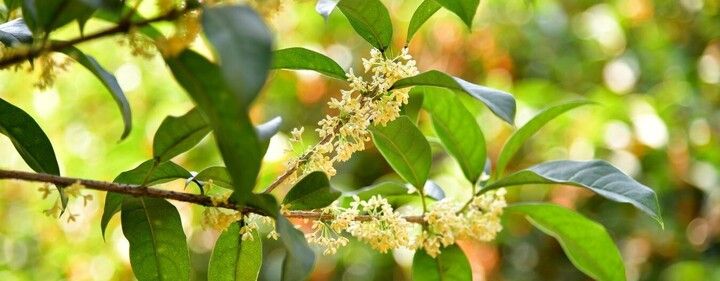




Fragrant Olive - Gui Hua
桂花 - Osmanthus fragrans
Golden flowers with an enchanting aroma, used for centuries in China to promote easier breathing.
1 Small Packet plant 50g
2 Small Packets plants 50g
Description
Osmanthus - A Floral Treasure for the Throat and Lungs
Renowned throughout Asia for its captivating fragrance, Osmanthus, or Gui Hua (桂花), is a precious flower harvested in autumn. Behind its delicate appearance lies a millennia-old heritage: in China, it accompanies cool seasons, heavy atmospheres, or moments when one seeks to regain a sense of lightness.
In Traditional Chinese Medicine, Gui Hua is known to act on the Lung and Stomach meridians, helping to move what is stagnant, disperse Wind, and harmonize energy in the upper body. It is said to “open the nose and throat,” bringing a sensation of lightness when feeling congested or slowed down, especially in cases of dry air, pollution, or dietary excess.
Its slightly warm nature and penetrating aroma make it a valuable ally during seasonal changes, helping to restore smooth breathing and inner clarity.

A Flower with Diverse Uses, Between Tradition and Delicacy
✓ For cool seasons or heavy air: Infused on its own or in a blend, it provides a sensation of a freer throat and smoother breathing.✓ A refreshing floral touch: To add to your teas to lighten the mind, refresh the palate, and perfume the breath.
✓ A culinary treasure: Used in syrups, jams, or steamed desserts, it awakens flavors while inviting relaxation.
A Medicinal Flower with Culinary Charm
The Chinese love Gui Hua also because it unites pleasure and care. It is infused to clear the lungs, added to tea for a warming and purifying effect, or mixed with glutinous rice or syrups to comfort the body without weighing it down.
Its highly distinctive floral fragrance is associated with clarity and mental sharpness: an ideal plant to restore smooth breathing and a calm mind.
Usages
As a tea – The daily floral infusion
Add 5 g of dried flowers to a large cup (250 mL) of boiling water.
Let steep for 5 to 7 minutes covered, then strain and enjoy hot.
Can be enjoyed on its own, or blended with green tea, chrysanthemum, or a few goji berries for an even more refined mix.
Recipes
Osmanthus Floral Syrup
- 1 tbsp dried Osmanthus flowers
- 100 g brown sugar
- 100 mL water
Gently heat the water and sugar, add the flowers, let simmer for 5 minutes. Strain.
Pour over yogurt, sticky rice, fruit, or even iced tea for an elegant floral note.
Steamed Sweet Glutinous Rice with Osmanthus
- 1 bowl steamed glutinous rice
- 1 tbsp dried Osmanthus flowers
- 1 tbsp cane sugar or brown sugar
- A few roasted black sesame seeds
Preparation:
- Rinse the glutinous rice thoroughly in cold water until the water runs clear.
- Soak in cold water for at least 4 hours (or overnight).
- Drain, then place the rice in your rice cooker, adding about 170–180 mL of water (slightly less than for regular rice, as glutinous rice absorbs water differently).
- Cook as you would regular rice. Let rest for 5 minutes after cooking.
Assembly:
- In a small bowl, mix the dried flowers with 1 tbsp sugar and 2 tbsp hot water.
- Let steep for 2–3 minutes to release the aromas.
- Pour this mixture directly over the hot rice, mixing well to distribute the flavors.
- Serve warm, with a pinch of roasted black sesame seeds if desired.
A traditional warm dessert, highly appreciated in Huaiyang or Hangzhou cuisine.
Warnings
Keep dry and protect from light and moisture. Keep out of reach of children. Food supplement reserved for adults and children over 12 years old. The use of this dietary supplement should not replace a diversified diet and a healthy lifestyle. Do not exceed the recommended daily dose. Not recommended for pregnant and breastfeeding women.










